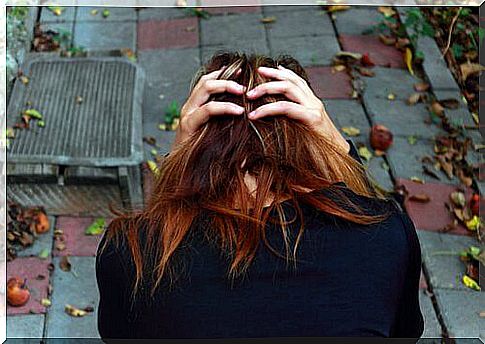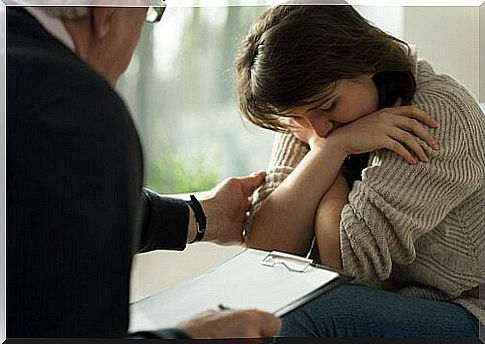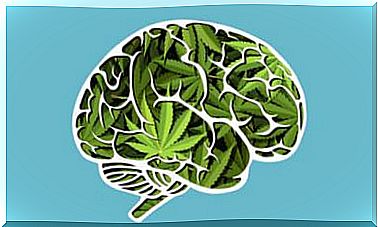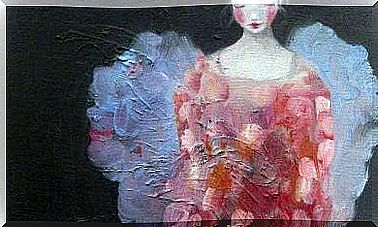What Is Agoraphobia? Symptoms And Treatment

Agoraphobia is a psychological disorder that is strongly linked to the anxiety attack. Although agoraphobia can exist without a prior history of anxiety or anxiety disorder, it is very common for these two psychopathologies to go hand in hand. This is why we believe that it is necessary to define the two concepts and to be situated in a broader conceptual framework. Thanks to it, the reader will be able to better understand what agoraphobia consists of.
The anxiety attack, also called in the scientific literature “panic attack” or “anxiety”, brings about the sudden appearance, in an isolated and temporary way, of the fear or the intense discomfort. It is often accompanied by certain characteristic symptoms, both physiological (palpitations or discharges in the heart, sweating, tremors, feeling of suffocation or strangulation, chest tightness, nausea or abdominal discomfort) and cognitive (feelings of unreality, also called derealization, altered self-perception or depersonalization, believing that you are going to lose control or go crazy, or think that you are going to die.)
Obviously, when you experience these physiological manifestations suddenly and adopt your thought patterns, everything takes on a catastrophic tone, which causes an even higher dose of fear. Thus, these primary symptoms of anxiety increase further.
The person will interpret it even more clearly that they are going to die or lose control of the situation and the symptoms will be even stronger.
The vicious circle is then initiated and will increase the anxiety to the point that the person will end up asking for help or worrying about the people around them, and who will ask for help for them. Other behaviors characteristic of this type of anxiety have a link with avoiding places that are anticipated as potential sources of anxiety, fleeing them if the person is there, taking anxiolytics, etc.

These behaviors are called safety behaviors and their purpose is to prevent the possible catastrophe that the patient imagines in his head. What is the problem with safety behaviors? This is because they only work in the short term.
That is, if the person, when they notice their symptoms again, takes an anti-anxiety medication, drinks water, or runs away from the situation, they will see that these unpleasant sensations will go away. Thus, the leak supposes a negative reinforcement which will make that in the future, the person will use it again. In fact, each time, she will limit herself more because this avoidance does not allow her to learn that in reality, nothing so terrible is going to happen. She’s not going to die or lose control. She won’t go crazy either.
The fact of escaping does not allow him to realize it. The only thing she gets is to prove herself right. She believes that thanks to her flight and her choice to adopt safety behaviors, she is safe and sound.
In reality, the patient is making a biased interpretation. He mistakenly believes that these symptoms can kill him / her because they resemble those of heart attack or psychosis. But you should know that the fact that they look alike does not mean that they are the same.
It is true that these are symptoms specific to anxiety, due to the fact of having endured too many adversities in life, which, like a pressure cooker, end up exploding, sending a message to the person: it is time. to stop for a bit and regain balance and inner peace.
When does agoraphobia arise?
Agoraphobia then arises when the person who has suffered from these anxiety attacks several times contracts the horrible fear that they will manifest themselves again in concrete situations. This fear is motivated by the idea that she may experience a seizure again and that it will be difficult for her to get help.
The subject presents, here, what one calls “the fear of fear”, and this fear of his own fear, which one could metaphorically explain with the image of the child who is afraid of his own shadow. and who tries to escape it, leads to avoiding all the situations in which the crisis has arisen as well as all those which resemble it.
For example, if your panic attacks took place in a supermarket, it is possible that over time they will become widespread in places like movie theaters, malls, and even some public transport.

Finally, this limitation can also give rise to depressive feelings, because the patient stops obtaining positive reinforcements from those around him. Each time he feels more incapable, his self-esteem drops and his despair increases.
What is the underlying cause?
There are several explanatory factors that try to answer this question, although they are not always present in cases of agoraphobia (with or without anxiety attack). Some authors speak of the following factors as facilitators of the disorder:
- The attention focused on his own feelings.
These are people who have a special sensitivity to detect any change in the body. They are people who are constantly attentive, whether consciously or unconsciously, to their bodily reactions and fluctuations and who take them as benchmarks to anticipate all the dangers we have discussed previously.
Thus, when a physical symptom appears, such as those described above, subjects notice it immediately, thereby increasing their state of anxiety. This theory has great empirical support, as demonstrated by the study carried out by Ehlers, Margraf, Roth et al. (1980) in which patients with anxiety disorder significantly increased their anxiety when they perceived that their heart rate had increased.
- Chronic hyperventilation
When hyperventilating, compensated respiratory alkalosis occurs (with near normal blood pH), that is, the levels of carbon dioxide and bicarbonate in the blood are lower than in control subjects. These levels make them more susceptible to anxiety attacks and they end up suffering from agoraphobia.
- Childhood separation anxiety
Authors such as Silone, Manicavasagar, Curtis, and Blaszczynski (1996) consider agoraphobia to be related to separation anxiety reactions that take place in childhood. Separation anxiety can make the subject more vulnerable to avoidance behavior that develops during panic attacks and that results in agoraphobia.
- A greater number of “stressful” events
There are also certain unprecedented environmental factors, such as the loss of a job, a romantic break-up or the loss of a loved one that can also act as facilitating factors for the onset of a crisis.

- Genetic factors
In twins / twins, if one of them has the disorder, the other is likely to have it as well. Relatives of people with anxiety disorders have a higher 25-32% risk of suffering from an anxiety disorder.
What is the treatment for agoraphobia
Since it is a fear of our own fear, that is to say the symptoms that we talked about previously, the treatment will be directed towards overcoming this fear and being able to have a normal life. This general objective, for its part, encompasses other more specific objectives that the patient gradually achieves when he / she follows therapy.
Even if the psychological treatment is not exactly the same whether it is an anxiety attack with or without agoraphobia or a simple agoraphobia without a history of anxiety attacks, they have some commonalities. In this article, we will stick to the treatment of agoraphobia. First of all, the patient needs to know what is happening to him and for this, psycho-education must be used. Psycho-education is not a psychological technique in itself, but helps the person to understand what is happening to him in order to normalize it.
It is a question of explaining to the patient what his disorder consists, what are the causes, why it persists and what will consist of the treatment.
Once the patient knows their disorder and the treatment options they have, the therapy itself can begin. For our part, we will focus on cognitive behavioral therapy because it is it that has the most support and empirical evidence. The treatment will have two well differentiated parts: a cognitive part and a behavioral part.
The goal is, on the one hand, for the person to change their beliefs and misconceptions about their symptoms and the situations in which they must cope. On the other hand, she must be able to expose herself to these so-called situations without safety behaviors, in order for anxiety to decrease and for her distorted thoughts to be changed.
Cognitive restructuring is the technique chosen when we work with thoughts. It consists of asking questions to the patient in order to dismantle their negative and irrational thoughts that cause the disorder to continue.
Thus, the patient sees himself / herself obliged to modify his / her ideas and to replace them by others, more adjusted to reality. For example, if the patient says they are afraid because they are anticipating a heart attack, they can be asked the following questions: “What data do you have that leads you to this thought?” “How do you know you’re going to have a heart attack?”
Another cognitive technique that can be used is behavioral experience. It is cognitive in nature because the objective is to disassemble the thoughts of the patient. The person and his / her therapist must agree on a situation in which the patient will have to expose himself / herself.
The patient writes down whatever they think might happen and experiences it. Then he observes and thinks about whether what happened really fits with what he thought was going to happen.
While cognitive techniques are essential in helping the person with agoraphobia cope more calmly with situations that cause anxiety in them, behavioral techniques, held over time, really allow the disorder to go away completely. When we talk about behavioral techniques, in the context of agoraphobia, we are talking about actual exposure in vivo .

The patient, with his / her therapist, must develop a hierarchy of anxiety-provoking situations: from the one that produces the least anxiety in him to the one that produces the most. They are evaluated according to Subjective Anxiety Units (USAS) which range from 0 to 10. Some situations will also include safety behaviors, but gradually these will have to be eliminated, until the person is able to cope with them. situations like any other person who does not suffer from this disorder.
To carry out this exposure in a suitable way, it is not too much for the patient to learn relaxation techniques. Some options are breathing-based relaxation or Jacobson’s breathing. This will allow him to carry out the exposure more easily.
A situation will be given as resolved when the patient notices that their anxiety has dropped significantly, and they can fend for themselves. Only then can we move on to the next situation, but never before. Otherwise, one can induce sensitization instead of habituation and that is not the goal.
If the exposure to reality is successful, the patient will get used to it. Thus, from physiological aspects, their anxiety will drop to normal levels and they will learn and internalize the realistic idea that nothing as terrible as they imagine ultimately takes place.
Generally speaking, this is the treatment for agoraphobia. However, depending on the case to be treated, other strategies can be included such as training in social skills, addressing depressive symptoms, eliminating secondary gains, etc. In some more specific cases and with more time to evolve, it may be recommended to combine therapy with pharmacological treatment.
Ortiz-Tallo, M. (2004) Trastornos psicológicos . ( “Psychological disorders” ), Edición Aljibe.
Moreno, P. (2007) Tratamiento psicológico del trastorno de pánico y agorafobia. Manual para terapeutas. ( “Psychological treatment of panic disorder and agoraphobia. Manual for therapists” ), Nuevas psicoterapias. Desclée.
Barlow, DH (1988). Anxiety and its disorders: The nature and treatment of anxiety and panic . New York: Guilford Press
Also read:









